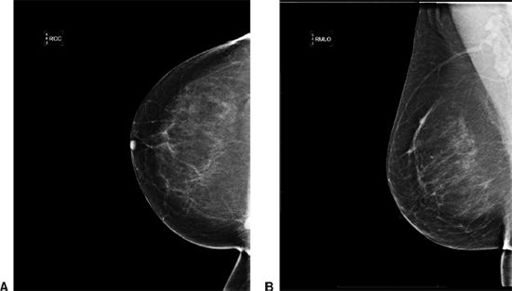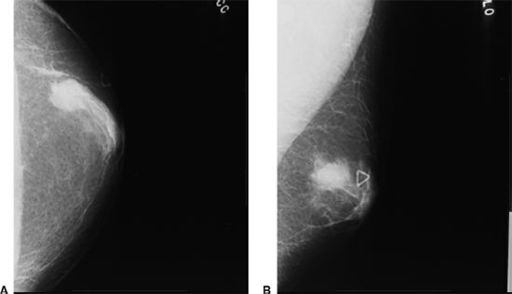Breast Imaging: A Core Review (18 page)
Read Breast Imaging: A Core Review Online
Authors: Biren A. Shah,Sabala Mandava
Tags: #Medical, #Radiology; Radiotherapy & Nuclear Medicine, #Radiology & Nuclear Medicine
A. BI-RADS 2, benign
B. BI-RADS 3, probably benign
C. BI-RADS 4, suspicious
D. BI-RADS 6, known malignancy
12
A 29-year-old female, who is 35 weeks pregnant, presents with a palpable lump in the right breast with associated pain. She denies any fevers. No skin erythema is seen on physical examination. Ultrasound images of the palpable lump are provided. No mammogram was performed due to patient’s age and pregnancy. What is the most appropriate next step?

A. Probable abscess, treat with antibiotics and short interval follow-up ultrasound.
B. Probable abscess, recommend drainage/aspiration.
C. Probably benign, lactating adenoma, or fibroadenoma, recommend short interval follow-up ultrasound in 6 months.
D. Suspicious mass, recommend ultrasound-guided core biopsy.
13
A 51-year-old female presents for a diagnostic mammogram, no prior studies are available for comparison. Based on images, what is the most likely diagnosis?

A. HIV
B. Tuberculosis
C. Metastases
D. Sarcoidosis
E. Rheumatoid arthritis
14a
A 70-year-old female presents for breast MRI to assess for possible implant rupture. Bilateral axial T1-weighted and left breast axial T2-weighted STIR water saturation images are provided. What type of implant is present?

A. Saline, prepectoral
B. Saline, retropectoral
C. Silicone, prepectoral
D. Silicone, retropectoral
14b
Which statement best describes the finding seen in the axial T2W STIR water-saturated image of the left implant?
A. Intact implant with normal radial folds
B. Intracapsular rupture only
C. Intact implant with capsular contracture
D. Intracapsular and extracapsular rupture
15
A 65-year-old male is diagnosed with breast cancer. Regarding breast cancer in males, which statement is correct?
A. Breast cancer in males in general has a better prognosis than in females due to the malignancy typically being in an earlier stage at the time of diagnosis.
B. Approximately 20% have axillary adenopathy at the time of diagnosis.
C. Approximately 15% have DCIS associated with their malignancy.
D. Infiltrating lobular carcinoma is less common in men than women.
16
What is the protocol for performing rolled craniocaudal (CC) views?
A. Always roll superior half of the breast medial and lateral.
B. Always roll inferior half of the breast medial and lateral.
C. Always roll medial half of the breast superior and inferior.
D. Always roll lateral half of the breast superior and inferior.
17
A 50-year-old female presents with a right breast palpable abnormality at 9 o’clock. Based on the ultrasound image below, what is the most likely diagnosis?

A. Extracapsular silicone implant rupture
B. Intact silicone implant with a focal bulge
C. Intact saline implant with a focal bulge
D. Intracapsular silicone implant rupture
E. Saline implant rupture
18
A cluster of calcifications are seen in the medial breast on the CC view but not seen on the MLO view. What additional mammographic view would be helpful to localize the calcifications?
A. Medial lateral (ML) view
B. Lateral medial (LM) view
C. Spot compression view
D. Cleavage view
E. Exaggerate craniocaudal outer view
19
Mondor’s disease of the breast is typified by which of the following statements?
A. Easily differentiated from inflammatory breast cancer
B. Common disorder characterized by thrombophlebitis of the subcutaneous veins of the anterolateral chest wall
C. Presents as a tender palpable cord corresponding to a superficial tubular density on mammography and a subcutaneous vessel on ultrasound without Doppler vascular flow
D. Rare malignant breast condition that requires biopsy or excision
20
A 56-year-old woman presents for a screening mammogram. Based on the two standard mammographic views A and B, what is the most likely diagnosis?

A. Lymph node
B. Invasive ductal carcinoma
C. Radial scar
D. Inframammary fold
E. Sternalis muscle
21
You are shown a standard screening mammogram. What is the MOST appropriate NEXT step?

A. 1 year follow-up
B. 6-month follow-up
C. Spot-magnification views
D. MRI
22
A 76-year-old male presents with a painless palpable breast lump. Based on the mammograms A and B, what is the most likely diagnosis?

A. Abscess
B. Hematoma
C. Mastitis
Other books
The Falling Away by Hines
Blaze (The High-Born Epic) by Jason Woodham
Minimalism: Live a Meaningful Life by Joshua Fields Millburn, Ryan Nicodemus
Lentil Underground by Liz Carlisle
The Surgeon's Doorstep Baby by Marion Lennox
Shattered Dreams by King, Rebecca
Fludd: A Novel by Hilary Mantel
Summer of Supernovas by Darcy Woods
Blood in the Valencian Soil (Secrets of Spain) by Baker, Caroline Angus
Saints and Sinners by Edna O'Brien